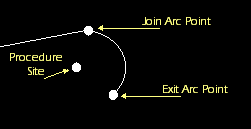An Arc Point to Point procedure is a maneuver along the perimeter of a circle of a user-specified radius, in which the velocity vector of the aircraft is maintained perpendicular to the vector from the current position to the procedure site. The center point of the circle is the procedure's site.
If the aircraft cannot achieve the defined altitude (either by using the default cruise altitude or by specifying an altitude), the aircraft will finish the maneuver at the highest or lowest altitude it could achieve, depending on whether it was ascending or descending; no warning will be given.
The procedure contains three control points - the procedure site, the Join Arc point, and the Exit Arc point - as indicated in the diagram below. The Join Arc point is placed relative to the procedure site, along the Start Bearing and at a distance equal to the Radius. The Exit Arc point is placed at the end of the arc as defined by the Turn Angle.
Click the image to view a detailed diagram.
Altitude
| Parameter | Description |
|---|---|
| Use Aircraft Default Cruise Altitude | Select this check box to define the altitude of the procedure using the default cruise altitude specified in the currently selected cruise performance model. |
| Start Arc Alt |
The altitude of the aircraft at the beginning and end of the arc, if you are not using the default cruise altitude of the aircraft. The altitude is constrained by the lowest ceiling value of the active performance models in the current mission phase. |
| Stop Arc Alt |
Arc Options
| Parameter | Description |
|---|---|
| Turn Direction | Select the turn direction of the arc from the start bearing. |
| Start Bearing |
The bearing, from the site, where you want the aircraft to begin flying the arc. Specify a True or Magnetic north reference using the drop-down menu. For example, if you specify a Start Bearing of 180 degrees, the aircraft will begin the arc at a point that is due south of the site (and at a distance from the site that is equal to the Radius parameter). |
| Radius | The radius of the circle. This will be the distance that the aircraft maintains from the site as it flies the arc. |
| Turn Angle |
The length of the arc that the aircraft will fly, measured from the start bearing. For example, if you specify a Turn Angle of 90 degrees from a Start Bearing of 0 degrees, the aircraft will fly an arc that transits the northeast quarter of the circle around the site, ending at a point that is due east of the site. |
| Join Arc |
Select from the following options:
This field is inactive if the airspeed of the aircraft is too high to provide enough room to make a turn with the specified radius and arc angle. |
| Exit Arc |
Select from the following options:
This field is inactive if the airspeed of the aircraft is too high to provide enough room to make a turn with the specified radius and arc angle. |
Arc Cruise Airspeed
Arc Cruise Airspeed parameters define the airspeed performance characteristics of the aircraft during the arc segment of the procedure.
Table - Arc Cruise Airspeed Parameters![]()
Enroute Options
Enroute Options define the turning performance characteristics of the aircraft during enroute segments of the procedure.
Table - Enroute Options Parameters![]()
Enroute Cruise Airspeed
Enroute Cruise Airspeed parameters define the airspeed performance characteristics of the aircraft during enroute segments of the procedure.
Table - Enroute Cruise Airpseed Parameters![]()
Enroute Turn Direction
Enroute Turn Direction parameters define the direction that the aircraft will turn during enroute segments of the procedure.
Table - Enroute Turn Direction Parameters![]()
Airspeed Profile
Select a method for attaining the procedure's cruise airspeed from the following options:
- Fly cruise airspeed profile (immediate change) - the aircraft adopts the selected cruise airspeed at the beginning of the procedure
- Arrive on cruise airspeed (gradual change) - the aircraft begins accelerating or decelerating in the previous procedure so that it arrives at the beginning of the procedure at the selected cruise airspeed.
Vertical Plane Options
Vertical Plane Options parameters define the flight path angle of the aircraft during enroute and arc segments of the procedure.
| Parameter | Description |
|---|---|
| Start Arc FPA | The pitch angle of the flight path at the beginning of the arc. |
| Stop Arc FPA | The pitch angle of the flight path at the end of the arc. |
| Radius Factor | The Radius Factor is the maximum amount - expressed as a multiplier - that the radius of a vertical curve will be increased to minimize the flight path angle required to complete it. The full circles that correspond (or are tangent) to the start/stop curves at the extended radius may not intersect if the Radius Factor is set high enough. This parameter is a limit and may not actually be achieved due to the requirement to generate an appropriate curve sequence. You can adjust the slider or enter the value manually in the box, with the minimum value being 1 and the maximum value being 10. |
| Min Enroute FPA | The minimum pitch angle of the flight path during enroute segments of the procedure. |
| Max Enroute FPA | The maximum pitch angle of the flight path during enroute segments of the procedure. |
